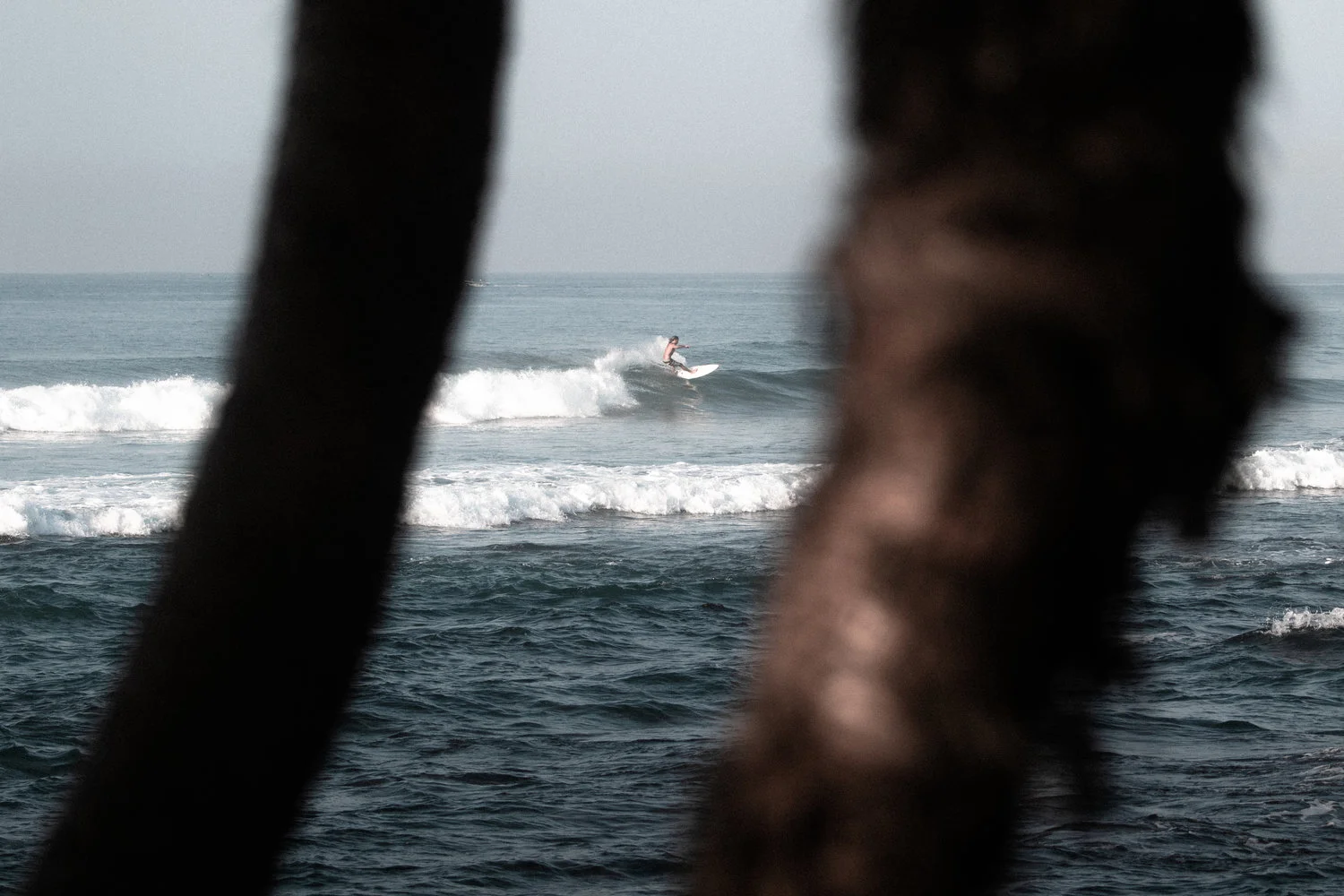Conditions and breaks
Sri Lanka’s beautiful Southern Province has consistent swell all year round. From Hikkaduwa in the north down to Hirketiya in the south you’ll find an endless amounts of surf spots. Reef, point or beach break – we’re lucky to have it all! The tidal change in Sri Lanka is relatively small and therefore most of the spots work through all tides. Our home break is Weligama Bay, but within a radius of 5 km you’ll find breaks ranging from pealing longboard waves and hollow barrels.
When to go where?
The southern coast of our beautiful island faces high- and a low season. The surf however, is consistent all year around. The peak season runs from December to March. During this period is dry season and it is not as windy when monsoon season kicks in. On the downside, the waters get crowded.
From May to October monsoons hits the South. Luckily, this doesn’t mean heavy tropical rain all day around, just a few showers every now and then. During these months, the swell is strong and consistent – but is accompanied with onshore wind. Monsoon season attracts more advanced surfers but is also an excellent season for beginners who are still learning how to surf. If you’re looking to avoid the crowds, this is your pick!
Surf spots overview
Hikkaduwa
Hikkaduwa is one of the most known surf towns in the south. What used to be a small fishing village is now crowded by surfers, divers and tourists. The surf is good and the nightlife is epic.
Benny’s
Left hander, reef break for the experienced surfers.
Main Reef
Left and right handers. The reef lies deep so the spot is relatively safe.
North Jetty
Long left that rolls in over the reef. Located by the harbour.
Beach Break
Sand and reef shore break. Perfect for beginners!
Rathgama
Owakanda Surf Pont
Between Hikkaduwa and Galle you’ll find the Owakanda Surf Point. The spot has both a reef break and beach break and suits beginners and experienced surfers. Very consistent and a good option if Hikkaduwa is too crowded.
Galle
Galle is famous for its old imperial city centre and Fort (check out our post about doing a day trip to Galle), but also have some surf when the conditions are good.
Clossenberg (Deweta) Beach Break
A beach and beginner break with crumbling waves that rolls in over sand. Only works up to 4 ft and the polluted water can be a problem, especially after a heavy rain.
Unawatuna
Unawatuna is one of the most developed tourist destinations in the south with a high range of hotels, hostels and restaurants. Here you will find the place for the backpacker as well as the lush luxury retreats. It has a mellow beach break, suited for beginners and a few reef breaks that rarely work.
Dalawella Reef Surf Point
Left hander over a reef break. Hazards include the reef, coral, rocks and sea urchins.
Bonavista Bay Surf Point
Good beginners break that works between 3-5 ft when the swell is right. It’s located just north of the Unawatuna temple peninsula.
Wijaya Beach Right (Dalawella Beach)
Breaks close to the rocks and to the shore. For intermediate to experienced surfers, as the wave breaks over rock and sometimes shallow reef.
South Beach Surf Point
Deep reef break that breaks both left and right. Perfect for longboarders, often best in the mornings. Located just north of Kabalana.
Kathaluwa
Sticks
Left reef break suitable for intermediate to advanced surfers. Located between South Beach and Kabalana.
Ahangama
Kabalana, the Rock, Surf Point
Also known as Kabalana Main Surf Point, this famous A-frame reef break attracts a lot of surfers. Works when the swell is small and big, and can hold up to 8-10 ft. Go early morning or sunset.
Kabalana Beach Break
Perfect beach break for beginners. Hazards are mainly the rip currents that can be very strong.
Rajith Surf Point
Reef break and A-frame, suitable for intermediate surfers. Located just south of the Ahangama fishing poles. Works up to 5ft.
Devil’s Rock
Devil Rock, also known as Sion Surf point, is a reef break that works both left and right and holds a 5-6 ft swell. Surf break for intermediates.
Midigama
Midigama right
Shallow reef break just north of the so called Lazy left. Paddle out from the beach rocks.
Lazy Left
A mellow left hand wave that breaks over a deep reef. Popular with longboarders and beginners catching their first waves on reef and is almost always busy. When the swell gets bigger the lazy left even attract the advanced surfers. Works best in low to mid tide.
Lazy Right
If you paddle to the right of the Lazy left, you’ll find the Lazy right. Similar to the left and thus attract the same crowd.
Ram’s right
This right hand wave is short, fast and hollow. Suitable for intermediate to advanced surfers as the wave breaks over shallow reef. Located just north of Gurubebila. Can get clean barrels holding up to 5-6 ft.
Coconuts
A-frame point break, a powerful wave that gives up to 400 m ride. Works best in high tide and can hold up to 6 ft. The entry point is either from the reef or from the sand bar on the right of the break. For intermediate or advanced surfers.
Plantations
Just right of Coconut is another reef break called Plantation. The wave is not as heavy and more suitable for the intermediate learning how to surf reef. Entry point is from the sand bar. Plantation goes left and right and can hold up to 4 ft with a 300 m ride.
Ketature Beach
Shallow reef break for intermediate to advanced surfers with a wave that breaks both left and right. Only works when the swell is big and can hold up to 4 ft. Only to be surfed on mid to high tide due to the shallow reef. Entry point is the sand bar in front the on the beach restaurant, that is in the middle of two reef sections.
Walliwalla
Jungle Beach
Jungle Beach is located in between Weligama and Midigama and has two reef breaks. The main one is a left hand break that can hold up to a 7 ft swell and with 500 meter rides! The wave is similar to the Lazy Left in form – but not as slow. The reef has some shallow parts to look out for.
The right hand reef break is more shallow and thus for the more advanced surfer. Paddle out from Ketatura Beach or out to the left break on Jungle beach and then around 600 meter paddle to the left.
Weligama
Our village and yours when you stay at Layback!
Fisherman’s reef
Popular among longboarders, the Fisherman Reef is a right hand break with peeling waves that holds between 3 to 5 ft. You have to paddle out from the new marina and the paddle is long. And we really mean long…don’t paddle out by yourself the first time as the reef is super shallow in some parts (and yes, some of us have dinged our fins on the way out or in…). Get one of the local guides or surfers to show you the way or pay one of the fishermen to take you out in his boat.
Weligama Beach Break
The Beach Break in Weligama Bay is the perfect beginner spot! All along the beach you’ll find different surf schools and places to rent a board. Super consistent, as the bay is a bit more protected from the wind compared to a lot of nearby spots. When other waves are blown out Weligama Bay might still work. Along the 2 km beach you’ll find several waves breaking left or right. It can get very crowded during peak season, so if you want an empty wave your best bet is early mornings.
Weligama Marriott Sand Bar
In front of the lush Weligama Marriott Resort is the deeper part of the beach break. The waves gets more powerful here and normally holds up to 4 to 5 ft. Favourite among longboarders, beginners and intermediates.
Taprobane Island
The main spots in the bay usually don’t work when the wind picks up during the monsoon. But fear not – the bay still got its waves. Around the Taprobane Island the waves still come rolling in during the summer months of July to October.
Mirissa
The Point, Mirissa
This scenic spot is a favourite spot for many. The point is a reef break with a low powered wave. A favourite among longboarders. The wave also breaks closer to the rocks and the shore. Watch out for the sea urchins and the reef when you get in and out. Entry point is either on the sand bar on the right side of the big rock, or close to the stairs down to the beach.
Turtle bay, Mirissa
Reef and left hander that is near the harbour. Good for beginners going intermediate and want to learn how to surf a reef break. Watch out for the reef when the tide gets low.
Polhena
Sabine Reef
Polhena is located 2 km from the bigger city Matara. In front of the Sabine Hotel you will find a reef break that has a fast left- and right hander. Works up to 6 ft when the swell is good.
Madiha
Madiha Surf Point
Reef break for intermediate and advanced surfers. Consistent wave that gives a 350 meter ride.
Dondra
Dondra Surf Point
The most southern point in Sri Lanka, but the waves only works when the swell is good. Watch out for the strong rip and the open sea.
Meddawatta
SK Town, Beach Break
South of Matara you’ll find a sandy beach break that is perfect for beginners and a favourite for longboarders.
Talalla
Talalla Surf Point
The Talalla bay with its 2 km beach is close to the town of Tangalle. The sandy beach break is good for beginners. Close to the café you’ll find a small reef break with low powered waves.
Dickwella
Hiriketiya Bay Beach Break
The Hiriketiya Bay with its 500 meter horseshoe shaped cove is a beautiful spot for both beginners and intermediate surfers. The bay is located just south of Dickwella.
Hiriketiya Bay Reef Break
The reef break in the left corner of the bay is a perfect intermediate spot. The wave is a powerful left hander that holds up to 8 ft. The shallow coral reef can be a problem – the closer you get to the beach the more shallow it gets. Sea urchin mine field.


